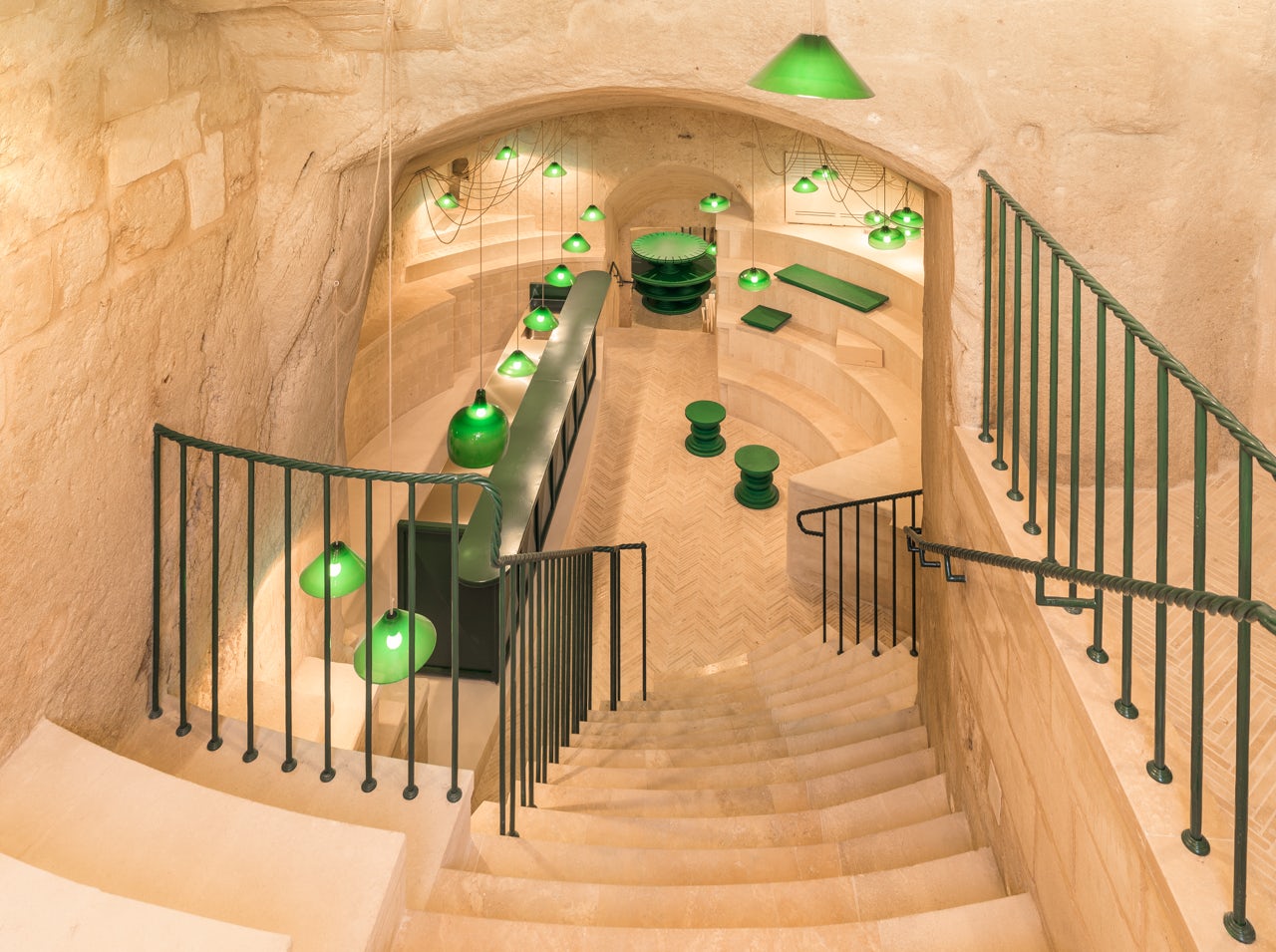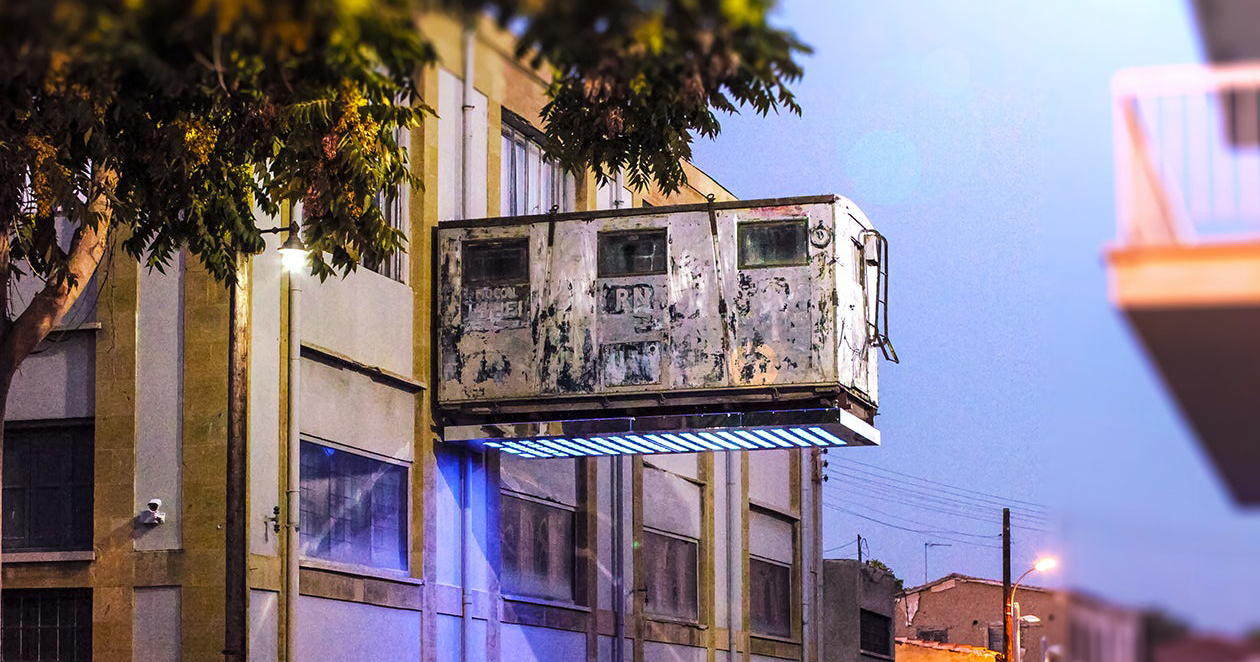“I want to see the first glass of red wine spill,” confesses Jan De Vylder, the third in a trio of principals that forms the Flanders-based architecten de vylder vinck taillieu. “I want to hear a glass break in this new space.”
It is the opening night of the Enoteca dai Tosi, a project conceived by Gianpaolo Buziol and curated by PS, a Milanese strategic consultancy agency headed by Michela Pelizzari and Federica Sala. The project for this wine bar in the southern Italian town of Matera began as a competition in which five architectural studios — Francesco Librizzi, StudioErrante Architetture, Andrea Caputo, muller van severen and architecten de vylder vinck tailleu — were invited to present concepts for a three-level winery inside of a sasso.


Once the “shame of Italy,” Matera has become one of the country’s treasured jewels, known for its houses dug into intricate rock formations — called “Sassi” after the Italian word for stones — and underground water cisterns that have earned the city its nomination as a UNESCO World Heritage site. A Sasso is a typical typology of Matera architecture, which consists of a space carved out into the rock that flanks the mountain and which dates back to the Paleolithic Age. Matera is situated by a canyon, and while it is possible to see remnants of Sassi on the eastern side of the canyon, the main conglomeration exists west of the water body, as settlers found softer stone to build into there and kept the opposing side for agricultural land and cattle grazing.

Matera had been a quiet town, removed from the Italian landscape by its unique social and living structure. In 1945, the city came to light when the Italian artist and author Carlo Levi stumbled upon it during his year of political exile in the Basilicata region, where Matera is located.
He published his observations in a memoir titled Christ Stopped at Eboli, which recounts the desperate poverty that plagued these rural towns: the lack of clean running water and sewage systems, the high infant mortality rates and the uncivilized living habits of Materans, who often shared tight living quarters with their large families and animals. The book’s title refers to the town of Eboli near Naples and suggests that civilization had never reached southern Italy, leaving it lawless and barbaric.

The book circulated, and Matera became synonymous with the disgrace of the nation, the shame of Italy. The Italian Prime Minister Alcide De Gasperi visited the town in 1950 and was so shocked that he planned the relocation of the Sassi’s entire population to housing developments built slightly outside of the city, where the now-modern Matera sits.
The memories that remain of Matera’s Sassi are very dark, but the people remember the community most, living close to neighbors and sharing day-to-day habits such as baking bread in communal ovens. Over the years, cultural treasures were discovered in the Sassi — rupestrian churches covered with priceless Byzantine frescoes — and a tide of incomers started settling again in the 1980s, interested in restoring the decaying treasure. In 1993, UNESCO listed the Sassi as a World Heritage site, driving further interest from commercial ventures that were attracted by the thought of developing tourism in these charming typologies.
Despite the transformation, the values that characterized the revival of the Sassi have persisted, and individual entrepreneurs, rather than commercial chains, are putting genuine effort into restoring and reactivating the national heritage. Traditional restaurants serve simple foods in unpretentious settings, bringing visitors back in time and constantly retelling the story of Matera.


It is in this setting that Gian Paolo Buziol, the youngest son of the established Buziol family, first dreamt of his project for the Enoteca dai Tosi, a space to savor quality Italian wine in a simple setting at the heart of the Sassi. The competition was announced at the end of 2016 and judged by a panel of experts, and the design of architecten de vylder vinck taillieu was selected to be built the following year.
“The stone for wine will be a stone of Matera,” wrote the architects in their document for the contest. Indeed, throughout their innocuous design, the stone of Matera embraces the inhabitants of the space: the visitors and the wine itself. The stairs, made of local tuffo stone, flow through the entire space, rounding out rooms and offering seating options that can be customized and transformed through the moving of furniture elements like green planks, stools and triangular stone blocks sitting on bleachers. The tuffo is the rock that makes up the mountain on which Matera is built and can be excavated at varying consistencies dependent on the depth of the excavation. This allowed the architects to work with more or less porous materials for different uses throughout the project.

Courtesy of architecten de vylder vinck taillieu
“We wanted to work with the material on-site […] and to go as far as possible using that material to make everything,” explains De Vylder as he walks us through the rooms of the Enoteca, connected by the continuous staircase digging into the Matera mountain. In the end, of course, practical objects like the railing, the bar and the lights were needed, and the architects turned to the local green color — the original color of the entrance door to this particular Sasso and a color that conveniently makes reference to the container of the wine, the translucent green bottle — to highlight those elements. De Vylder attributes this craft to his collaboration with local architect Michele Andrisani.
“Working with someone like Michele, who is really from around and working here [was] not only very helpful, but very fundamental in understanding how things [could] be made,” recounts De Vylder. From the original drawing of the staircase, Andrisani helped the architects understand the construction techniques for intervening in the Sasso and directed the works for the project in this remote geographic location. There is an ambiguity to the project, in that a visitor may wonder what the architect’s hand touched. The intervention is so careful and so respectful of the existing space that it feels at first as though it is the product of a discovery, carved out of the rock many years prior.


We enter the Enoteca through the patio, where a bright red neon light shines — the design work of a Milan-based multidisciplinary creative consultancy La Tigre, which also conceived the Enoteca’s overall brand identity. We walk down the main staircase, which first leads to a traditional bar facing four levels of circular bleachers before plunging into a deeper space where the wine cellar sits visible behind a simple glass partition.
The bottles lie directly on the stone. De Vylder explains that while this detail may slightly scratch the bottles, it also symbolizes the mark of the house on its products and reduces the distance between all elements of the space — bringing the inhabitants of the space to closest proximity with the matter of the city itself.


From the first room, a succession of cisterns also offers additional spaces to sit in a more intimate setting. The Enoteca offers a variety of conditions for gathering, replicating the patterns of the city so that groups of people are able to conglomerate around the bar, on the stairs or anywhere on the bleachers of the spherical rooms. “There are no tables, no chairs here, only stools, because the city is the chair,” says De Vylder. “You can move often, gather things around, making opportunities for people to meet.”
From the original Sasso, nothing has been removed. The architect has added a tiled floor and kept the original openings as directions for the layout of the Enoteca. “When you see the door openings, you could say it’s unfinished, but it’s very much finished because it’s an opening someone once made to [get] to the cistern.” To De Vylder, this is a trace of history and of previous life that is inevitably a part of the project.


The form of the bleachers is reminiscent of the process by which Matera inhabitants were quarrying rock out of the Sassi themselves to build above. “These things you should not try to design or correct or to be annoyed by,” says De Vylder. The fast turnaround for the project — competition and construction — allowed the architects to be very intuitive with the details of their design, leaving as much of it to natural conditions.
In the evening, a handful of journalists and many locals gather around the space and are offered wine from the whole of Italy and a tasting of local antipasti. Buziol, Andrisani, De Vylder and the members of PS all rejoice in seeing the Enoteca vibrant with life, resonating with soft voices and the smell of prosecco.
When conceiving the project, Buziol’s hope was to create a space that celebrated Matera’s cultural potential and provided an attraction for Matera locals to begin inhabiting the Sassi once again. This very special collaboration has achieved a most fitting place for this — an elegant intervention that utilizes the qualities of Matera’s material and historical composition to offer a space for neighbors to socialize at the heart of the Sassi. We raise a glass to it!
All photographs courtesy of Delfino Sisto Legnani









